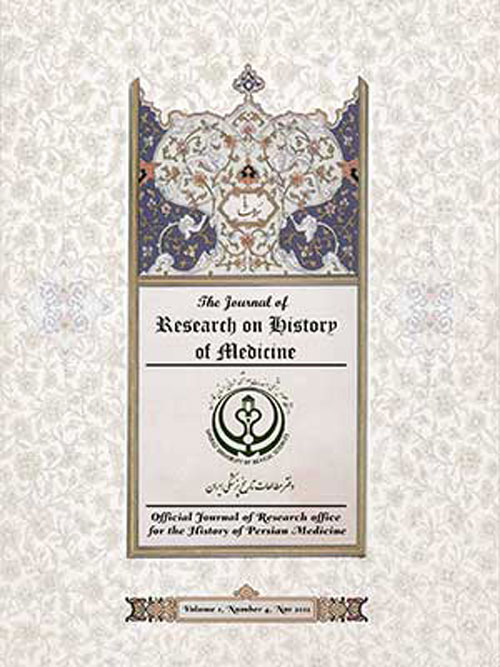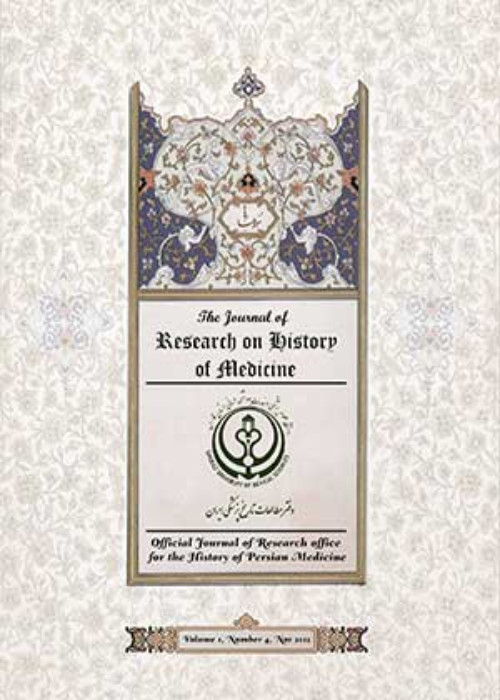فهرست مطالب

Journal of Research on History of Medicine
Volume:11 Issue: 3, Aug 2022
- تاریخ انتشار: 1401/06/02
- تعداد عناوین: 8
-
-
Pages 143-168During the Qajar period in the 19th century, various epidemics including cholera infected most parts of the country every year. Cholera appeared as a contagious and non-indigenous disease that spread in different parts of Iran including Hamedan province during the Qajar period as the prerequisite unfavorable conditions existed. Hamedan is a province located in the western part of Iran, a mainly mountainous region that is one of the inland foothills of the Zagros Mountains located in the valleys and northern slopes of the Alvand Mountains. It has long been the most important communication route between western cities and central Iran. During the Qajar period, this province was sometimes affected by cholera which is a contagious disease due to the unfavorable political, social and cultural condition in this period and became widely inflicted. The purpose of this study is to analyze the background and factors leading to cholera outbreak in Hamedan since the Nasserite era to the end of the Qajar period (AD 1848-1925) by collecting information in a library and documentary method with a historical and descriptive approach along with the analysis of backgrounds of cholera outbreak in the timeframe (AD1848-1925) and seeks to answer the questions that what are the backgrounds and factors that led to the outbreak of cholera in Hamedan during the Qajar era to see which one had a greater role in the spread of this disease? Findings indicate that the inefficiency and a lack of sense of responsibility of the government of Hamedan due to authoritarianism and self-interest had played the major role in the spread of cholera epidemic in this region compared to other factors.Keywords: Cholera, Hamedan, Causes, contexts, Qajar Dynasty, History, Epidemics
-
Pages 169-180
Spanish flu outbreak is one of the historical catastrophes in southern Iran, Kerman provinces, and citie Kerman, which wiped out most of the population. The epidemic began on October 29, 1918 and continued until 1920 in several waves. Within three years, the population of Kerman due to a Persian famine and disease was reduced from 50,000-60,000 to around 25,000-30,000. In rural areas of Kerman province, there were up to 100% deaths. It effectively killed half the population of the city and caused serious damage to its demographic context and economic development. A rather unpleasant remnant of the epidemic is Tandarestan Cemetery in Kerman, which is the burial place of a large number of people and celebrities such as Nazim al-Islam Kermani (1861-1918), a famous historian, writer and journalist. This article explores the importance of local medical history in Kerman, the effects of the flu outbreak, World War I, and the presence of the British that led to a man-made famine, and malnutrition, and finally the role played by this colonial government in amplifying the flu outbreak, Wrong prescription of opium and decimation of the city. This study examines the type of Spanish flu in Kerman, the death toll and the treatment of British troops for the people.
Keywords: History of medicine, Spanish flu, Kerman, Iran, Britain -
Pages 181-196The conquest of Iran by the Arab armies resulted in radical political and social changes in Iran. The connection of local rulers to the Caliph in Baghdad and the peaceful coexistence of different ethnic groups facilitated the movement of the population in other parts of this territory. Population movement has always brought the transfer of knowledge and culture, and host countries have welcomed immigrants with high scientific degrees. Therefore, such immigrants play a crucial role in advancing that science in the new territory. Physicians’ migration from Jundishapur to Baghdad, the center of the caliphate, is an excellent example of this situation. This phenomenon resulted in (a) Iranian medicine transfer, (b) hospital construction, (c) medical textbooks translation, and (d) medicine’s advancement in Baghdad. The primary purpose of this research was to examine the migration of Iranian physicians and their role in transferring Iranian medicine to Baghdad and its consequences. The results of this study were as follows: (a) the ease of movement after the conquests, (b) the migration of Jundishapuri doctors to Baghdad, and (c) the invitation and religious tolerance of the Abbasid caliphs for doctors, which led to the prosperity of medicine in Baghdad and the Islamic world. Although Jundishapur University lost its prestige due to the migration of physicians to Baghdad, and such reputation disappeared later, medical science continued to exist in Baghdad and made significant progress.Keywords: migration, Medicine, Jundishapur, Physicians, Baghdad, Translations
-
Pages 197-212The city of Kufa was built in 17 AH during the reign of the second caliph in Mesopotamia. During the first centuries of Islam, a large population settled there. In the social dimension, the Kufis needed the services of skilled physicians with different specialities. Although little is known about the medical knowledge and physicians of Kufa at that time, many historical events show clear signs of the flourishing of Kufa medical knowledge in the first centuries of Islam.This research, with a descriptive-analytical method, tries to answer these questions: what was the status of medical knowledge in Kufa from the beginning to the end of the fifth century of Hijri? And who were the famous doctors of Kufa? Research findings show that in the centuries mentioned, there were a significant number of physicians with different specialities including Muslims, Christians and Jews in Kufa who were either Kufis themselves or came to this city and provided medical services to the rulers, governors and people. They were hygienic and at the same time wrote and translated medical works, the most famous of which were Athir ibn Amro al-Sukuni, Abdul Malik ibn Abjar, Jabir ibn Hayyan Azdi, Yaqub ibn Ishaq Kendi, Theodor Tiyazuq and Euphrates ibn Shahnatha.Keywords: History of medicine, Kufa, Physicians, Civilization, Islam
-
Pages 213-220Sa’fe disease is one of the skin diseases that has caught the attention of physicians of the Islamic ages. An ulcer on the head with small and scattered pimples has been regarded as the most significant symptom of this disease, sometimes making the patient’s face red. Generally, the condition is classified into two categories, dry and wet, with specific symptoms and treatments. The most significant signs of this disease include dry ulcers on the scalp and much dandruff, sometimes leading to baldness. The general treatment of this disease, which primarily affects the head and sometimes the face, includes blood collection in leprosy, cupping and leech therapy, regular washing with medicines and preparation of all kinds of poultices and oral medication. It should be noted that it is more common on the head and sometimes on the face. This disease is more prevalent in children than adults. Accordingly, this study was conducted to explain Sa’fe condition and mention the various symptoms and treatments stated in Islamic medical sources to remove this disease using the library method.Keywords: Medicine in the Islamic Ages, Skin diseases, Sa’fe, Physicians, Ulcer
-
Pages 227-230


